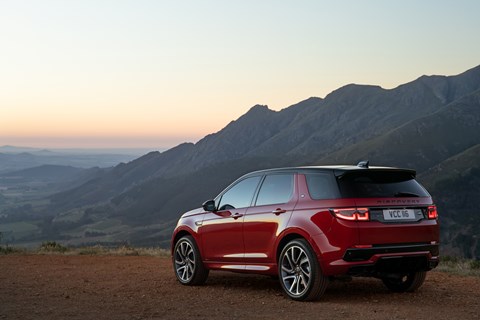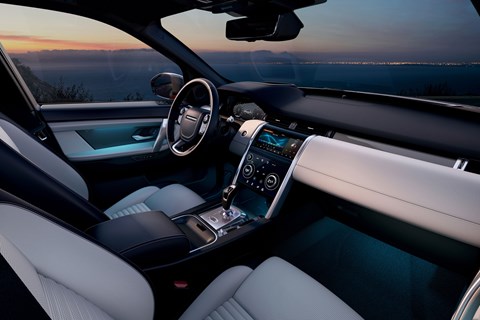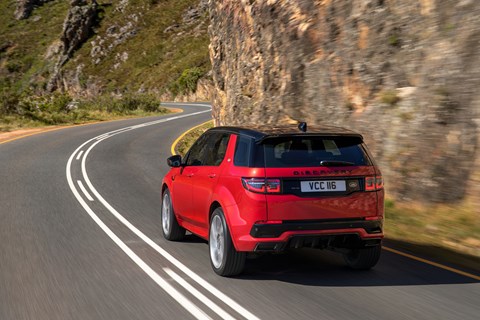► New Disco Sport has Velar cabin details
► Mild hybrid tech rolled out across range
► Tweaked styling keeps things fresh
Until the new Land Rover Defender arrives in 2020, the Discovery Sport is still very much the entry point into green oval ownership right now. But such is the pace of change, this gateway Land Rover is very much a premium product in its own right, which is why this mid-life facelift is so important. It’s the brand’s best-selling car, with 438,000 examples built since launch.
But it’s being chased hard by some very impressive new SUVs, and although the Disco Sport wears its off-road stripes with pride, as an on-road compact exec, there are an increasing number of newer rivals, which do it better.
In its mid-life facelift, Land Rover is hoping to set that right. The 2019 Disco Sport boasts an uprated interior, with improved infotainment, updated tech, and a much more ‘premium feeling’ cabin. We’ve seen similar improvements in the recent Jaguar XE facelift, and although they weren’t game-changing, they do improve the car’s appeal significantly. We’re expecting the same here.

The same goes for the way it looks – the 2019 Disco Sport looks very much like the 2015 original. So, it gets reprofiled front and rear bumpers, wider track, new front and rear LED lights, and some new alloy wheel designs including 21-inch wheels available for the first time.
In other words – it’s a gentle nip ‘n’ tuck of an admittedly good-looking SUV. That’s still enough for design director Gerry McGovern to say, ‘Building on the success of the original Discovery Sport, this beautifully proportioned vehicle has been refined, enhancing its characterful exterior which compliments the engaging nature of the interior space.’ Andy wheel, chief designer on the Disco Sport project is more direct, saying: ‘we’re putting more sport into the Sport’
What’s changed under the skin?
The biggest news is the Disco Sport’s move to JLR’s Premium Transverse Architecture (PTA), which was introduced on the L551-generation Range Rover Evoque. The uprated monocoque is now 13% stiffer than before and it features new rigidly-mounted subframes – the upshot of these improvements is better suspension control and (hopefully) lower levels of noise.
The new platform’s remodelled rear floor allows for the introduction of the new 48-volt mild hybrid electric vehicle (MHEV) powertrains, which also debuted on the Range Rover Evoque. It uses an engine-mounted belt-integrated starter generator to harvest energy and store it in an under-floor battery. So, you get coasting below 11mph, and the stored energy is used to make take-off smoother.
As before, the Disco Sport is powered by JLR’s modular Ingenium range of petrol and diesel engines. The most economical front-wheel drive D150 version delivers CO2 emissions from as low as 140g/km (NEDC) and up to 47.8mpg combined (WLTP). Land Rover says that the three-cylinder PHEV variant will join the range in later 2019.
Land Rover says the Disco Sport is one of the first Real Driving Emissions stage 2 (RDE2) certified engines offered in its class. We’re also pleased to see Land Rover reverse the current trend towards tiny fuel tanks, upping the Disco Sport’s to a useful 67 litres.
The engine line-up looks like this:
- D150 front-wheel drive
- D150 four-wheel drive
- D150 MHEV front-wheel drive
- D150 MHEV four-wheel drive
- D180 MHEV four-wheel drive
- D240 MHEV four-wheel drive
- P200 MHEV four-wheel drive
- P250 MHEV four-wheel drive

What’s the new Disco Sport like inside?
Land Rover says that the biggest change is the quality of the interior, and the introduction of more ‘premium’ materials transforms the cabin. We’ll reserve judgement on that, but similar changes to the Jaguar XE have made a difference. It also gets new seats across each of the three rows and the additional ability to 40:20:40 split-fold and slide the centre row.
Disco Sport regulars will no doubt spot the fitment of the digital Touch Pro infotainment system that made its debut in the Range Rover Velar. It’s widescreen system with a large landscape-format screen, and is just about on the pace of the opposition – a real improvement over what came before. You don’t get the ‘Duo’ lower screen of the Velar, but you get ‘secret ’til lit’ controls that mirror that car, using the same twin-knob heating and secondary controls.

You also get a ‘smart rear-view mirror’, like that fitted to the Range Rover Evoque, which usefully improves rear visibility when the boot is loaded or you have rear-seat passengers.
Any other tech we need to know about?
Lots of new features previously seen in the Range Rover Velar and Evoque have made their way into the Disco Sport. You now get Ground View technology. This is LR’s clever forward view system that uses projected camera imagery to offer a virtual 180-degree view beneath the vehicle which is displayed on the touchscreen. Other new features include wireless charging, a 4G WiFi hotspot, and USB and 12-volt connectivity points on every row of seats. There’s also a reversing camera as standard on all models.
Standard safety features include Lane Keep Assist, Autonomous Emergency Braking and Driver Condition Monitor, and if you are start ticking the options boxes, you can also have Adaptive Cruise Control with Steering Assist. As we say, it’s an incremental improvement, that largely brings the Disco Sport up to the level of its rivals.
When can I buy one and how much is it?
The new Land Rover Discovery Sport is available to order now, with deliveries starting from autumn, and is priced from £31,575 for the standard front-wheel drive in D150 form, and tops out at £48,575 for the P250 R-Design in HSE form. The PHEV model arriving around six months after that.

Echoing the way Jaguar now does things, the Land Rover Discovery Sport is available in standard and R-Dynamic body variations, and each of those comes in S, SE and HSE trims. How can you tell a standard Disco Sport from an R-Dynamic? Look for the sportier bumpers and body coloured sills and arches.
Check out our Land Rover reviews